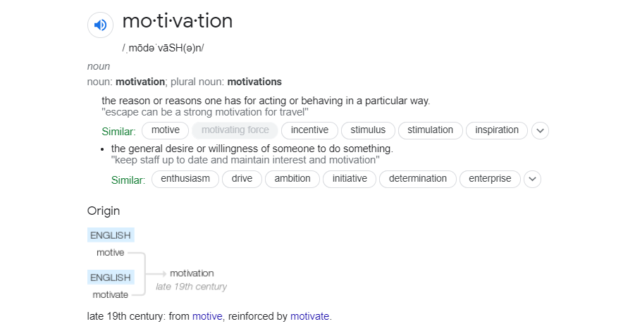If your employees aren’t motivated in the workplace, hitting targets, coming up with innovative ideas, and keeping morale high will become impossible.
But motivation can be difficult to quantify. Just because your employees are meeting KPIs doesn’t necessarily mean they feel motivated or fulfilled in their roles. And if they don’t feel comfortable speaking up, it can be difficult to notice a motivated vs. unmotivated workforce.
So, the next time you’re in the office or speaking with an employee, look out for these signs of motivation (or demotivation) that your team might be displaying.
What is motivation?
Before discussing the different types of motivation and some crucial examples of motivation in the workplace, let’s establish what motivation is.
The dictionary defines motivation as “the reason or reasons one has for acting or behaving in a particular way” or “the general desire or willingness of someone to do something.” It comes from the Latin word “movere,” which means “movement.”

Maslow’s hierarchy of needs is a good starting point for understanding where motivation comes from and what drives us to “movement.”
What are the types of motivation?
There are numerous types of motivation, both in the workplace and in general life. Understanding the types of motivation in psychology is a great starting point for learning how to motivate others in the workplace and beyond and will give you the motivation skills you need to help your business thrive.
Psychologists tend to break motivation into two main categories: intrinsic and extrinsic.
Intrinsic motivation
Intrinsic motivation comes from within. It’s driven by close-held beliefs and values, such as acceptance, honor, desire to achieve, and curiosity.
In other words, intrinsic motivation is all about what makes you feel good without an external reward.
Intrinsic motivation examples:
There are a few ways someone can demonstrate intrinsic motivation, but a few examples include:
- Going to the gym to lose weight
- Improving your diet
- Learning new skills
- Playing games or sports for fun
- Helping someone with no expectation of reward
- Donating to or volunteering with a charity
Extrinsic motivation
If intrinsic motivation is all about internal motivators, it shouldn’t surprise you to learn that extrinsic motivation is triggered by external factors: rewards, recognition, or avoidance of punishment.
Extrinsic motivation examples:
- Monetary rewards, such as bonuses, raises, and/or other perks
- Societal expectations (for example, to buy the latest smartphone or designer clothing)
- Students studying to impress their parent(s)
- Fear of losing your job if you’re consistently late or absent from work
- Parking in a designated area to avoid fines
Why is motivation in the workplace important?
Motivated employees are likely to work harder, develop better ideas, and generally become an asset. Unmotivated employees can drag the whole team down, as well as cause problems for the mental health of the individual.
But it’s not all about mental and emotional wellbeing. Studies have found that highly engaged and motivated teams offer businesses a multitude of benefits, including:
- High productivity levels – Engaged and motivated employees are around 43% more productive than unmotivated individuals.
- More innovation – Research has found motivated employees are more creative and are more confident when sharing ideas for business improvement.
- Higher profits – Businesses with “higher than average” employee motivation and engagement benefit from 27% higher profits, 50% more sales, and 50% improved customer loyalty.
- Lower levels of absenteeism – Studies found highly engaged work teams realize a 41% reduction in absenteeism.
- Lower staff turnover – A survey of over 50,000 employees found motivated team members are 87% less likely to leave a company… That’s five times lower than unengaged individuals!
- Greater business reputation – When staff members are happy, fulfilled, and highly motivated, they will be driven to provide a better customer experience and spread the word about how great your company is.
- Stronger recruitment capabilities – Companies with low staff turnover and an excellent reputation are a far more attractive prospect for job seekers, allowing you to pick the very best candidates.

15 signs your employees are motivated
Now that you know what motivation is and some of the benefits of employee motivation in a company, how can you tell whether your team is engaged and motivated?
1. They’re smiling
It might sound simple, but smiling is an easy indicator that someone is happy and fulfilled in their job, and is a critical component of spotting motivation…. After all, if someone finds pleasure in their work, they’re likely to be intrinsically motivated to perform well.
In addition to looking out for smiling faces, it’s also a good idea to pay attention to the language your team uses in meetings and general conversation. Employees who consistently use negative, pessimistic language, for example, are likely to be unhappy, unmotivated, and/or disengaged. Conversely, if employees regularly use positive language when speaking about the business or their jobs, they’re probably experiencing job satisfaction… Essential for motivation!

2. They show up to work early or are willing to stay later
If your team is happy and motivated at work, spending a few extra minutes in the office won’t be a big deal. Both intrinsic and extrinsic motivation can cause employees to work overtime, for example:
- Intrinsic motivation to come in early, stay late, or volunteer for overtime may relate to a genuine desire to provide excellent service, help the team, or that they’re taking pleasure in work.
- Extrinsic motivation for overtime is likely motivated by a fear of punishment. Employees may not want to be penalized for lateness, so make an effort to come in early. Alternatively, extrinsic rewards may be motivating, for example overtime pay or promotion opportunities.
3. They take initiative
Highly motivated individuals don’t feel the need to wait for “permission” to complete a task. They’ll see tasks that need doing and get on with them for the sense of achievement caused by a job well done. This initiative “can-do” attitude is an excellent sign of motivated employees.
4. They’re not afraid to challenge management
In addition to showing initiative, motivated and fulfilled employees won’t be afraid to challenge management if it improves the business. This intrinsic motivation usually stems from an innate desire to be successful and experience achievement.
So, motivated people will speak up if they don’t feel that management isn’t giving them (or the company as a whole) the best chance for success.
5. There’s evidence of teamwork and comradery
Highly motivated teams are made up of individuals who are willing to help and support each other. But it’s not just teamwork and helpful behavior you should look for here… Keep an eye out for genuine friendships within the office as a sign of employee motivation.
Remember, making friends is a form of commitment and investment. Friendship takes time and effort, and an employee that’s not engaged won’t bother.
If your workplace is full of friends working together to achieve a common goal, chances are, you have an engaged and motivated workplace.

6. They participate in after-hour work events
Like making friends in the office, keeping an eye on who does/does not attend after-hours work events can be worthwhile.
Social events outside of work are an excellent opportunity for employees to develop bonds that improve teamwork and comradery. So, attendance can be a good indicator of whether an individual is interested in making friends with their colleagues and that they see “work” as more than a paycheck.
7. There’s minimum absenteeism or responsibility avoidance
When someone is dissatisfied and unmotivated, you might spot excessive absenteeism… While they could have legitimate reasons for this, it’s most likely that they simply don’t care enough about the job.
Conversely, highly motivated team members will make an effort to attend every work shift and may even stay later or arrive earlier to help out.
Similarly, motivated employees will be more enthusiastic about taking on additional responsibilities or accountability. Unmotivated individuals are unlikely to volunteer for extra work and will often be seen doing the “bare minimum” they need to keep their jobs.
8. They seek feedback and self-improvement
Motivated people want to make things better at every opportunity. The best way to achieve this is by actively asking for feedback.
If you have an employee who regularly asks for feedback and guidance, this is an excellent sign that they are motivated by self-improvement and are eager to succeed!
9. They look for opportunities to learn
Intrinsic and extrinsic motivation can both stimulate a desire to learn. Intrinsic motivation is fuelled by an innate curiosity and desire to know more. Extrinsic motivation might see a new skill as a way to receive rewards such as a raise or promotion.
Whether motivated by intrinsic or extrinsic rewards, an employee who shows an eagerness and desire for learning and self-improvement at every opportunity is always an asset.
10. They volunteer for challenging assignments
We mentioned that seeking feedback and working overtime are excellent examples of motivation in the workplace. Still, the types of roles, assignments, and responsibilities your employees are willing to take on can also tell a story.
When individuals successfully complete a challenging project, they feel a sense of accomplishment and pride in their work. This is usually linked to intrinsic motivation, but a financial reward for the task could also be a driving factor.
Engaged and motivated team members will actively seek out these challenging projects to grow their skills, impress leadership, and instill a sense of pride in their work.
What’s more, after successfully completing a challenge, these motivated employees are likely to seek out more challenges.
11. Their energy levels are high
When you walk into an organization filled with motivated individuals, there’s a sort of “electricity” or charged atmosphere in the air. This energy is contagious, and you can’t help but feel motivated and stimulated in this type of environment.
Simply put, when people are motivated, they’re energized and enthusiastic. And it’s something you can feel in their air.

12. They keep their work areas tidy
There is a case for a messy desk being a sign of intelligence and creativity… However, if an employee regularly leaves work stations, kitchen areas, or meeting rooms in a mess, this could be a sign of demotivation and unhappiness in the workplace.
Keeping the places you spend your time in clean and tidy is a fundamental part of staying healthy, productive, active, and proud. So, keep an eye out for people willing to clean the breakrooms or have an organized/clean desk.
13. They don’t waste company resources
Similarly to keeping the workplace clean and tidy, employees committed to the business will respect company resources. Consider things like how often an employee asks for additional supplies, whether they turn off lights when they leave a room, or whether they power down their computer at the end of the day. These little conservation-friendly activities are often indicators of an employee who cares about the company and is dedicated to seeing the business thrive.
14. They provide feedback
When employees are motivated and happy in their workplace, they’re more likely to feel comfortable sharing their ideas to move the business forward.
It’s vital to look after those who take the incentive to actively improve the business and workplace culture. These people are showing some impressive motivational skills and will always be an asset to the company.
15. They customize their positions
The perfect job rarely exists without some customization. And studies found that employees who are given autonomy to work on projects and customize their roles are often more productive and happier in their jobs.
Therefore, when you give your employees the power to be more flexible in their working hours or how they complete tasks, you may find this motivates them to work harder and achieve higher success.

And 7 signs employee motivation is lacking
While monitoring employee performance and attitudes for examples of motivation in the workplace can be beneficial, keeping an eye out for signs of disengagement or a lack of motivated behavior can also be beneficial.
The following un-motivation list will help you spot anyone who might need some extra support to achieve their full potential:
- They’re frequently late or slow to start work
- Their attitude towards their co-workers has changed, or they’re not engaging with colleagues
- There’s an increase in absenteeism
- They’re unfocused and/or distant
- They’re noticed making inappropriate or negative comments
- They’re not engaging in team meetings
- They are reluctant to take on extra responsibility in the workplace
What causes demotivation in the workplace?
It can be tempting to reward a motivated person and disregard anyone who’s not demonstrating focus or engagement… However, there are many reasons someone might feel disengaged in the workplace.
Rather than leaving this group behind, try to understand the causes for their behavior and ask how you can help improve their performance.
While this isn’t a definitive list, the following can all cause a person to lose motivation towards work:
- Boredom
- Lack of confidence in management
- An unmanageable workload or unattainable targets
- An unwelcoming or unsuitable work environment
- A lack of career progression (or information about career pathways)
- Feeling unappreciated
- External issues unrelated to work – for example, family illness, bereavement, or health/financial struggles

How to improve motivation in the workplace?
Now you know how to separate a person’s competence from their motivational skills; if you want to be a great leader, you need to know how to encourage and empower your team to achieve their full potential.
1. Recognize great work
Employees will often feel demotivated if their great work or helpful attitude goes unnoticed. Therefore, it’s essential to recognize and reward inspirational motivation examples.
Remember, this doesn’t always need to be money (although money is a fantastic extrinsic reward). Simply providing praise for excellent performance can be a valuable intrinsic motivator that your group may appreciate.
2. Communicate openly and regularly
In line with providing recognition and incentive for great work, it’s crucial to ensure your employees have a trustworthy line of communication with management. This could involve a detailed grievance procedure and regular team meetings with constructive feedback and praise.
Remember, communication between management and staff should always feel like a safe space. If you’re not ensuring your team feels safe speaking to you, they’re unlikely to take the initiative, and you could be missing out on valuable information.
3. Offer challenging work
Boredom is a common reason a person will disengage with work and will demonstrate reduced levels of productivity. Keep focus high by providing challenging and rewarding projects that your team can volunteer for, and be sure to recognize their achievement.
4. Make sure everyone understands the impact their work has (set the “why”)
Frequently, employees will become unmotivated when they don’t really understand why they’re completing a particular task. To combat this, a good leader will explain how the employee’s job impacts the broader goals of the business.
5. Set clear, achievable targets
A recent Gallup poll uncovered that when employees are involved in the goal-setting process, they’re over three times more engaged than workers who aren’t given a say.
In addition, it’s also vital to break down big targets into smaller, achievable goals. These attainable chunks will help prevent your staff from feeling overwhelmed, and noticing when these smaller targets are hit will go a long way to ensuring your employees feel appreciated, satisfied, and as though their work has meaning.
6. Don’t micromanage!
According to a 2017 report, micromanaging is the top complaint employees have about their bosses. It kills everything from motivation to creativity and almost always leads to a reduction in job satisfaction.
On the other hand, giving your team some autonomy and empowering them to manage their own workdays leads to increased job satisfaction, happier workers, increased motivation, and better productivity across the board.
So, resist the urge to micromanage and let your teams get on with their jobs!
7. Create a welcoming environment
A sense of belonging is a vital requirement for humans, just like food or shelter. To keep your team motivated, try to create a work environment that feels welcoming and ensures everyone works as a team.
Sure, everyone won’t get along ideally every day, but making an effort to ensure the workplace is non-toxic and friendly will go a long way to keeping your team engaged and satisfied in their jobs.
8. Provide benefits and fair remuneration
Money is often considered the default extrinsic motivator. It’s tangible, measurable, and necessary for… Well, everything! And it’s a worthy incentive to encourage employees to work hard. If you’ve ever heard the term “pay peanuts, get monkeys,” you’ll know that you need to provide a fair wage for your staff if you want to get the best out of them.
However, thinking money is all that matters is a sign of lazy management. Sure, your employees should be appropriately paid for their work, but it’s not always about the money. In fact, studies found 9 out of 10 people are willing to earn less money if they can do more meaningful work.
What does this mean for you as a manager? Finding the perfect balance between money and meaning is the best way to keep your employees happy, engaged, and motivated.
Motivation is contagious
When you have the correct procedures and communication streams in place, you’re sure to notice more and more “motivated employee” behaviors. And offering trust and autonomy will allow you to feel confident that if anyone starts to feel disengaged, they can talk to you.
Remember, motivation (like smiling) can be contagious. If just one employee is happy and engaged in the workplace, you’ll be amazed how quickly these positive attributes can spread.
So, why not start the spread? Lead by example and engage in the workplace with a smile on your face. You might be surprised by the results.
FAQ
What are some examples of motivation?
Often, we think of money as a great motivator, but there are other examples of motivation: Intrinsic and extrinsic motivation.
Intrinsic motivation:
- Playing sports because you enjoy them.
- Improving your diet and fitness to feel healthier.
- Helping someone with no expectation of reward.
- Donating to a charity or cause you believe in.
Extrinsic motivations are all about external rewards. Money is a popular extrinsic motivation.
Extrinsic motivators:
- Working overtime for an increased chance at a promotion.
- Buying designer clothing to “fit in.”
- Studying hard because your parents want you to get an A.
- Fear of punishment – for example, losing your job or getting grounded.
How do you demonstrate motivation at work?
If you’re motivated at work, chances are you’ll display some of the following signs:
- Smiling
- Willing to work overtime to help the business
- Initiative
- Sharing suggestions
- Seeking feedback for work
- Participating in out-of-office events
- Volunteering for challenging projects
- Asking questions about career progression
What are good motivators in the workplace?
Money is often considered the best workplace motivator, but this is not entirely true. In fact, many people consider job satisfaction and meaningful work to be far better motivators than simply making money
To keep your team motivated, try:
- Laying out a clear career path
- Setting attainable targets
- Ensuring your team can speak to you honestly
- Involving your employees with goal-setting
- Leading by example with a positive attitude and friendly demeanor.
How can you tell if an employee is not motivated?
There are plenty of reasons why an employee might feel unmotivated or disengaged, and it’s essential to set a private, non-threatening meeting to see whether there’s anything you can do to help.
To spot someone who’s not motivated, look out for these signs:
- They’re frequently late or absent from work.
- They don’t engage with their colleagues.
- They’re unfocused.
- They make negative comments.
- They don’t engage in team meetings.
- They don’t take on extra responsibilities.




